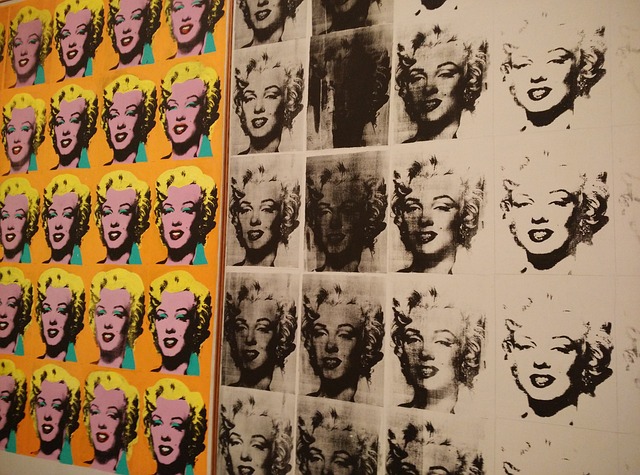“Being good in business is the most fascinating kind of art.
Making money is art and working is art and good business is the best art.”
-Andy Warhol
Andy Warhol is one of the highest paid artists of all time.
When he died, he was worth over $220 million dollars.
But what was the secret to his success?
Beginnings
Andy started work at an advertising firm.
He worked as an illustrator / graphic designer for magazine ads.
(Starting with PROVEN demand).
While honing his skill, a mentor taught him how to make silkscreen prints.
Inspired by this process, he decided to turn his ad illustrations into prints and started selling them.
Breakthrough: Dropshipping His Prints To The Fine Art Market.
Andy increased the perceived value of his prints by placing them in a different context.
It was the same exact product as before, only the presentation was changed.
This created a new style.
(The core of which was a capitalistic business model).
“I knew that work was going on, even if I didn’t have any idea what the work would come to.”
-Warhol
His work expanded into other mediums and became known as “business art”.
The personal brand it revolved around involved several roles:
- Portraitist
- Publisher
- Publicist
- Celebrity
- Salesman
And manifested as one work:
- Performance art
- Conceptual art
- Portrait art
The crazy thing is, he though his prints were selling for millions, he didn’t even have the rights to the his source material.
He only got the rights afterwards.
Campbell’s soup even gave him the rights because of all the free promo he was giving them.
This is similar to Ari Onassis using loopholes to run his tanker fleet.
He just got the job done and dealt with the “consequences” as they came up.
Finding Customers
1 of the key ingredients in biz success is choosing the right market.
(People who have money and are willing to spend it).
Andy understood this well, which is why he hung around rich people in rich environments to find wealthy clients.
He did this by going to the famous “Studio 54” in NYC.
(Establishing strong positioning in the flow of money).
This was THE hot spot where all the socialites, music / film stars, writers, and others hung out.
Warhol’s wealthy network eventually referred him to celebrities.
- Pelé
- Basquiat
- Mick Jagger
- OJ Simpson
- Muhammed Ali
- Michael Jackson
- Yves Saint-Laurent
- Etc
This association with celebrity gave his brand a “glow” (halo effect) and became synonymous with his name.
He received hundreds of portrait commissions from them.
In the early eighties, Warhol was painting about fifty clients a year, charging around $25,000 per commission, and $40,000 for a two-panel portrait – using this lucrative business to fund his other ambitious projects and sustain his factory.
“Spend enough time around the rich and eventually one of them will get drunk enough and say “I’ll buy it.”
–Warhol
Collectability Was Also A Key Aspect Of His Success
Many of Warhol’s prints played off similar themes.
- Fame and celeb culture
- Consumption
- Advertising
- Materialism
His source material:
- Isolates material from its context.
- Showcases ordinary / everyday objects.
- Borrows from mass media (TV, mags, comics).
- Reproduces, overlays, duplicates, and combines images.
- Uses bright / saturated / primary / neon colors with bold black lines.
- Enlarges and repeats objects (to emphasize the elements of fascination).
- Combines similar and dissimilar images as a collage (creating analogies to make a statement).
- Combines with other objects + images to create new associations that play on the main themes.
All of which allowed him to make infinite variations + “editions” of similar pieces.
This “gamified” his brand, which gave his customers an engaging experience and inspired them to buy more.
It also re-affirmed the cultural obsessions of the public.
His Process: “The Factory”
“I want to be a machine”
-Andy Warhol
What made Warhol’s art so revolutionary is that he leveraged an efficient system to increase his output.
It all went down at his studio called “the factory”.
What made his art different from traditional artists is that he didn’t spend hours on one painting.
His time spent in advertising made him interested in repetition and mass production.
He would make a master print and have his assistants make endless copies.
This allowed him to sell the same piece as many times as he wanted.
Another Key Strategy Was Monetizing His Everyday Activities.
Andy was a relentless chronicler of life and its activities.
- He was notorious for taking endless Polaroid photos of his lifestyle.
- He also kept a diary of the shocking observations he had about the crazy experiences he had. (Which reads like a series of tweets).
- Etc
All these habits built a massive portfolio of material which was eventually turned into books and sold as well.
I used a similar strategy by turning my best tweets into a book here.
(And it still pays me to this day).
Results?
All these strategies allowed him to build a fortune of $220 million while he was alive.
Andy’s creative risks changed the very definition of art.
His constant experimentation with subjects and media made him a pioneer in all forms of visual art.
His portrait of Marilyn Monroe is now the most expensive piece of artwork by an American artist ever sold at auction, selling for $195+ million.
Conclusion
- Start with demand
- Dropship it to other markets willing to spend more
- Just fkn send it
- Target customers that have money
- The “intangibles” + associations can make your offer a lot more valuable
- “Gamify” your brand to give your customers an engaging experience + affirm their beliefs
- Systemize your process to increase leverage
- Monetize your everyday activities
Want to learn more? Click the button below.
You May Also Like:
Ex-Hedge Fund Insider: This Simple Mental Model Prints Wealth
What Everybody Ought To Know - About Making A Swipe File
The Shocking Truth About How The Public School System Has Failed You
The Michael Jordan Success Story - How Did He Make His Fortune?
The Dangerous Life of an International Playboy - My Secret in Rio
Robert DeNiro: Profitable and Timeless Communication Principles
A Multi-Billion Dollar Business Lesson From Red Bull
Secret Paths to Success Only the Ultra-Wealthy Know About
My name is Mister Infinite. I've written 600+ articles for people who want more out of life. Within this website you will find the motivation and action steps to live a better lifestyle.


